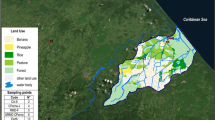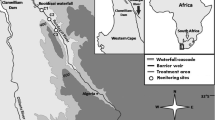Abstract
Two agricultural runoff events involving the pesticide azinphos-methyl occurred in July 2002 on the Wilmot River, Prince Edward Island, Canada, resulting in the death of thousands of fish. The fish communities from three sites on this river had been sampled in 2001, permitting comparisons of brook trout (Salvelinus fontinalis) and rainbow trout (Oncorhynchus mykiss) populations before and after the events. Samples taken immediately after the runoff events suggested that brook trout suffered higher mortality than rainbow trout. Young-of-the-year fish were more affected than older age classes for both species. Sampling in 2003, a year after the pesticide runoff events, revealed salmonid communities that were still skewed towards rainbow trout, and a decrease in the 1+ age class density (2002’s young of the year) at affected sites. These results suggest a differential effect of the pesticide azinphos-methyl on salmonid species and age classes under natural conditions, and a subsequent change in population and community structure. The possibility of these pesticide runoff events selecting for rainbow trout, an exotic species, is a consideration in management of agriculturally impacted rivers.




Similar content being viewed by others
References
Arnold H., Braunbeck T., (1994). Disulfoton as a major toxicant in the Rhine chemical spill as Basle in 1986: Acute and chronic studies with eel and rainbow trout. In R. Müller, R. Lloyd, (eds). Sublethal and Chronic Effects of Pollutants on Freshwater Fish, Don Mills, Ont., Oxford University Press, pp. 75–87
Atchison G.J., Henry M.G., Sandheinrich M.B., (1987). Effects of metals on fish behavior: a review Environ. Biol.Fish. 18: 11–25
Elson F.P., (1967). Effects on wild salmon of spraying DDT over New Brunswick forests J. Fish. Res. Board Can. 24: 731–67
Gormley, K.L. (2003). Assessing the impacts of stream habitat and land use variables on population and community structure of salmonids of Prince Edward Island. University of Prince Edward Island, MSc. thesis, 176 pp
Hansen D.J., Matthews E., Nall S.L., Dumas D.P., (1972). Avoidance of pesticides by untrained mosquitofish, Gambusia affinis Bull. Environ. Contam. Toxicol. 8: 46–51
Hansen J.A., Woodward F., Little E.E., DeLonay A.J., Bergman J.L., (1999). Behavioral avoidance: possible mechanism for explaining abundance and distribution of trout species in a metal impacted river Environ. Toxicol. Chem. 18: 313–17
Johnston C.E., Cheverie J.C., (1980). Repopulation of a coastal stream by brook trout and rainbow trout after endosulfan poisoning Prog. Fish-Cult. 42: 107–10
McKim J.M., (1977). Evaluation of tests with early life history stages of fish for predicting long-term toxicity J. Fish. Res. Board Can. 34: 1148–54
Murty A.S., (1986). Toxicity of pesticides to fish, II. Florida, CRC Press, 143 pp
Mutch, J.P., Savard, M.A., Julien, G.R.J., MacLean, B., Raymond, B.G. and Doull, J. (2002). Pesticide monitoring and fish kill investigations on Prince Edward Island, 1994–1999. In D.K. Cairns (ed). Effects of Land Use Practices on Fish, Shellfish, and Their Habitats on Prince Edward Island. Canadian Technical Report of Fisheries and Aquatic Sciences No. 2408, 94–115
Parrish D.L., Behnke R.J., Gephard S.R., McCormick S.D., Reeves G.H., (1998). Why aren’t there more Atlantic samon (Salmo salar)? Can. J. Fish. Aquat. Sci. 55(Suppl. 1): 281–87
PEI DAF, Prince Edward Island Department of Agriculture and Forestry, Contour and 2000 Corporate Resource Inventory Layers. Prince Edward Island Department of Agriculture and Forestry, Charlottetown, PEI
Post G., Leasure R.A., (1974). Sublethal effect of malathion to three salmonid species Bull. Environ. Toxicol. Chem. 12: 312–19
Power G., (1980). The brook charr, Salvelinus fontinalis. In E.K. Balon, (ed). Charrs, Salmonid Fishes of the Genus Salvelinus. Kluwer Boston, Hingham, Mass, pp. 141–203
Saunders J.W., (1969). Mass mortalities and behaviour of brook trout and juvenile Atlantic salmon in a stream polluted by agricultural pesticides Can. J. Fish. Aquat. Sci. 26: 695–99
Smith J.R., (1984). Fish Neurotoxicology Aquat. Toxicol. 2: 107–51
USEPA, United States Environmental Protection Agency. (1998). Azinphos methyl. Case number: 0234. Chemical number: 058001. http://www.epa.gov/pesticides/op/azinphos/azm_01.pdf (2001). Interim reregistration eligibility decision for azinphos-methyl. Case no. 0235. http://www.epa.gov/REDs/azinphosmethyl_ired.pdf
Van Leeuwen C.J., Griffioen P.S., Vergouw W.H.A., Maas-Diepeveen J.L., (1985). Differences in susceptibility of early life stages of rainbow trout (Salmo gairdneri) to environmental pollutants Aquat. Toxicol. 7: 59–78
WHO, World Health Organization. (2002). Data sheet on pesticides: azinphos methyl. http://www.inchem.org/documents/pds/pds/pest59_e.htm
Acknowledgments
We thank all those who helped with field collection: Carrie Jardine, Erin Duffy, Eddie Francis, Nick Gautreau, Ben Moore, Melissa Abbott, Nancy Beaton, Todd Dupuis, Craig Durant, Rachael Eedy, Bonnie Gillis, Floyd Gormley, Nick Gormley, Doug Holdway, Neil Mater, and Lisa Purcell. The original funding for this project was provided by the PEI Department of Fisheries, Aquaculture and Environment. In-kind support was provided by the PEI Department of Agriculture and Forestry. Personal support was provided by an NSERC PGS-A, as well as the Canadian Council for University Women Margaret MacMillan Pratt Post-Graduate Scholarship in the Sciences. Additional funding came from the Olin Fellowhip provided by the Atlantic Salmon Federation and an NSERC Discovery Grant awarded to D. Holdway and K. Teather. This research was approved by the University of Prince Edward Island Animal Care Committee.
Author information
Authors and Affiliations
Corresponding author
Rights and permissions
About this article
Cite this article
GORMLEY, K.L., TEATHER, K.L. & GUIGNION, D.L. Changes in Salmonid Communities Associated with Pesticide Runoff Events. Ecotoxicology 14, 671–678 (2005). https://doi.org/10.1007/s10646-005-0017-5
Accepted:
Published:
Issue Date:
DOI: https://doi.org/10.1007/s10646-005-0017-5




